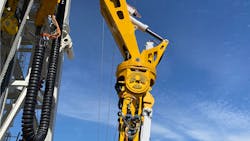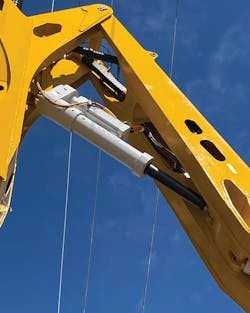A Safer Design for Oil & Gas Drilling Pipe Systems
The oil & gas industry faces some of the most-demanding machine design challenges for engineers, but the lessons learned are often transferable to other industries. This is especially true with motion control. Creating motion-control solutions for oil and gas rigs include safeguarding workers, preventing explosions, mitigating extreme pressure on drilling equipment, and handling the weight of heavy tools to tap and run a wellhead.
Drillmec is a global provider of oil field equipment and offshore drilling. The company recently developed its latest, fully automated pipe-handling system, dubbed the Stinger. According to Drillmec, automating the handling, assembly and racking of pipe for an oil rig with a system like the Stinger improves the efficiency of oil rig operations by 20% and eliminates accidents because workers don’t have to stand on the drill rig floor to assemble pipe. With the Stinger, Drillmec also wanted to build a product without relying on the large hydraulic power units and hydraulic cylinders it used with prior pipe-handling systems.
Turning to third-party experts with hydraulic, electric and hybrid actuation experience gave Drillmec insight to the best technology for the task. Eliminating hydraulic equipment with the Stinger’s design did away with the need for oil and tubing, which caused Drillmec extra installation time when mounting their previous technology on a rig, and in the event of a breakdown, there’s no risk of leakage.
Engineering an Integrated Design
The Stinger is attached to the lattice work of a drill rig’s tower and consists, in part, of a boom and stick. At the end of the Stinger’s stick is a gripper clamp that grabs a 9-meter drill pipe staged in a holding area. The Stinger grabs and precisely swings the pipe section into position at the wellhead for a second gripper clamp to grasp and hold. While the second gripper holds the first pipe segment, the Stinger retrieves two additional segments and raises its boom and stick to connect each 9-meter segment to create a 27-meter pipe that it inserts into the wellhead. This is work that “roughnecks,” or oil rig workers, often perform. The Stinger eliminates all but one worker who supervises the automatic cycle of the machine from the safety of an operator chair away from the drill rig floor.
The weight of the piping and size of the Stinger’s boom and stick required engineers to conceptualize and develop three of the largest electromechanical linear actuators ever developed for this kind of application, each with a stroke length of 800 millimeters (31.5 inches). Two of the three actuators have a stall/peak force of 120/200kN, and the third has a stall/peak force actuator of 210/300kN.
The engineers who worked with Drillmec also designed the actuators for hazardous operations, including ATEX and IECEx certification, and pressurized each actuator to avoid contamination from dust and sand. Among the design challenges was sizing and integrating these three linear actuators, three rotary actuators, and six compact multi-axis servo drives into the design of the Stinger, while keeping the design within a compact footprint.
The Stinger’s PLC controls the actuators with data sent via fieldbus to the servo drives to establish position and speed. Inherent in the design of the actuators was Drillmec’s need for a motion-control system that could operate continuously, with the only downtime being scheduled maintenance.
Most of the engineering challenges weren’t related to the dimensions of the actuator, since the engineers helping Drillmec had previously developed a bigger ball screw for another application. The most remarkable challenges involved:
- Implementing a new manufacturing method for the Stinger’s anti-rotation device;
- Developing a new pressurization concept to compensate for the variance of volume during the actuator’s stroke, while ensuring a positive pressure delta inside versus outside, so sand couldn’t contaminate the actuator;
- Designing an integrated ATEX safety brake to maintain the same footprint of the motor; and
- Creating a test methodology and tools to assemble a 300-kilogram (661-lb) actuator.
“To accomplish the motion-control design for the Stinger, we drew on our work for the power-generation industry,” said Roberto Cardani, director, Product Management for Moog. “Actuators we developed for inlet guide vanes and variable stator vanes on gas turbines were foundational for the Stinger’s actuator design.
The Stinger posed several motion-control challenges for scaling up a solution and integrating the various elements to achieve safety and efficiency. The solution applies not only to other oil and gas applications but also a range of other industries.
Bill Perry has written about the utility, manufacturing and aerospace industries for nearly 30 years and lives in Upstate New York. Contact him at [email protected].
About the Author
Bill Perry
Bill Perry has written about the utility, manufacturing and aerospace industries for nearly 30 years and lives in Upstate New York.

Leaders relevant to this article:


